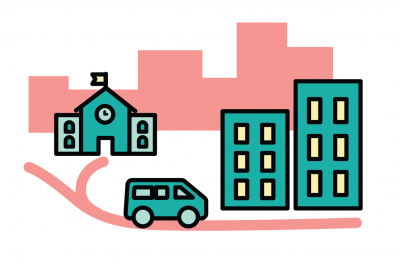 Essential Destinations
Essential Destinations
The role transportation enables access to essential destinations
People need to access many different destinations for essential and social purposes but some destinations matter more than others. Transportation access is particularly important to access jobs, healthcare, food and opportunities to be healthy like parks and open space, and educational opportunities.
A large body of existing work from Los Angeles and other regions has demonstrated how automobiles provide the most access to employment opportunities within a reasonable commuting distance. In most locations, the number of jobs someone can access within an hour by car is far greater than the number accessible by transit in that same time window. This is a result of a number of factors including historic patterns of residential segregation that still shape where people of color live to this day, suburbanization of people and employment, and transit service planning which focuses service on 9-to-5 commuting patterns into and out of downtown areas. In addition, transit travel is often cumbersome and inaccessible, especially for single mothers and low-income workers who work non-standard hours and conduct multiple trips in a day.
Much of the work around transportation and employment connections stems from the age of welfare reform where there was increased attention on the barriers those on welfare face in accessing employment. This work found that residential location and commute mode often determine what jobs welfare recipients can access. For welfare recipients who live in job-poor neighborhoods, the ability to find work is restricted by infrequent and unreliable transit.
Other recent work focused on the transportation connections to education and finds, among other benefits, that improved school transportation access typically leads to more sleep among students. Improved transportation options also provide students with a greater ability to attend a school further away from where they live. In California, there are almost no school bus operations and therefore, most students must rely on their parents, walking or public transportation to get to school every day. The main exception to this pattern is for students experiencing homelessness, in foster care, or those with disabilities, who by federal mandate, must be provided with school transportation free of charge. Recent research on this need examined the opportunity for tailored ride-hailing trips to provide school transportation for these students. Looking at foster youth specifically, school travel by ride-hailing provided opportunities for the students to remain in their school while their home location may vary, and that point-to-point service provided massive time-saving benefits over the logical alternative, public transit.
Last, other UCLA work on transportation access to essential destinations has examined the role that transportation can play in connecting people to healthcare and to parks. The lack of transportation is a barrier to consistent healthcare access and to opportunities to be healthy and physically active. While the shift to telemedicine is helping some people to overcome this barrier for particular conditions, opportunities exist to strengthen the connections between traditional public transit and paratransit services to social service and non-emergency medical transportation options. In terms of parks, the transportation barriers are typically smaller scale, mostly in the pedestrian environment. This work suggests that solutions like sidewalk maintenance, signal timing, and opportunities to sit and rest could help overcome existing transportation barriers to park access at the neighborhood scale.
Further Reading from UCLA Scholars
Blumenberg, E. A, & Ong, P. M. (2002). Cars, buses, and jobs: Welfare Participants and Employment Access in Los Angeles. UC Berkeley: University of California Transportation Center. Retrieved from https://escholarship.org/uc/item/8n55f7bd
Blumenberg, E., Miller, D., Schweitzer, L., Garrett, M., Kitkis, K., Manville, M., & Mallavarapu, B. (2003). California Transportation Needs Assessment: The Transportation Barriers and Needs of Welfare Recipients and Low-Wage Workers. UCLA: The Ralph and Goldy Lewis Center for Regional Policy Studies. Retrieved from https://escholarship.org/uc/item/0g04h3rt
Chen, K. L, Brozen, M., Rollman, J. E, Ward, T., Norris, K., Gregory, K. D, & Zimmerman, F. J. (2020). Transportation Access to Health Care During the COVID-19 Pandemic: Trends and Implications for Significant Patient Populations and Health Care Needs. UCLA: Institute of Transportation Studies. Retrieved from https://escholarship.org/uc/item/22b3b1rc
Loukaitou-Sideris, A., Brozen, M., & Levy-Storms, L. (2018). Bolstering Mobility and Enhancing Transportation Options for Low-Income Older Adults. UCLA: The Ralph and Goldy Lewis Center for Regional Policy Studies. Retrieved from https://escholarship.org/uc/item/5bt0m87c
Ong, P. M, & Miller, D. (2003). Spatial and Transportation Mismatch in Los Angeles. UC Berkeley: University of California Transportation Center. Retrieved from https://escholarship.org/uc/item/2664v2n7
Speroni, S. (2020). School Transportation Equity for Vulnerable Student Populations through Ridehailing: An Analysis of HopSkipDrive and Other Trips to School in Los Angeles County. doi:doi:10.17610/T6530N Retrieved from https://escholarship.org/uc/item/077181dh
